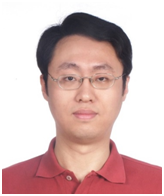
Speaker: Ji Wei
Place: Conference Room 318, Building 11
Title: Visualization of intermolecular non-covalent interactions and their roles in tuning properties of two-dimensional materials
Time: 6th June, 2019, 10:00-11:00 a.m.
Abstract:
Van der Waals forces were believed dominant for interlayer interactions in layered two-dimensional (2D) materials. We recently found an emergent type of interlayer interactions, namely covalent-like quasi-bonding (CLQB) [1,2], in various 2D materials like black phosphorus [1,2], PtS2 [3], PtSe2 [4] and few-layer Te [5]. This interlayer interaction is, most likely, directly observed in TiS2 by x-ray scattering [6,7]. Such technique also suggested charge accumulation in hydrogen bonds. We thus imaged intermolecular hydrogen bonds in real space using a qPlus non-contact Atomic Force Microscope with a CO terminated tip [8], which suggests a covalent characteristic of hydrogen bonds. However, it was argued that the contrast between molecules is a result of CO tip tilting [9], which boost extensive discussions in the field. In collaboration with our experimental and theoretical coworkers [10], we found an O atom modified Cu tip is of strong lateral stability which is an order of magnitude higher than the usual CO modified tip. It does not show the fake contract between two S atoms in the adsorbed DBTH molecule on Cu(110), but does show the N…N bond in BPPA and hydrogen bonds in PTCDA. In addition, we discussed the interlayer magnetic couplings (IMC) of CrS2 and CrI3 bilayers. It is interesting that these two materials are at two extremes of IMC. The interlayer FM coupling in CrS2 is very robust and is nearly unable to be tuned under usual external fields, but the intra-layer magnetism does be varied under layer stacking [11]. An opposite case was found in CrI3 bilayers [12] where the intra-layer FM coupling is, however, very strong but the interlayer magnetism was found governed by a subtle change of interlayer stacking; this shows a decoupled magnetic interaction between intra- and inter-layer directions.
References:
[1] J. Qiaoet al. Nature Communications 5, 4475 (2014)
[2] Z.-X. Hu et al. Nanoscale 8, 2740 (2016).
[3] Y. Zhao et al. Advanced Materials 28, 2399-2407 (2016).
[4] Y. Zhao et al. Advanced Materials 29, 1604230 (2017).
[5] J. Qiaoet al. Science Bulletin 63, 159-168 (2018).
[6] H. Kasai et al. Nature Materials 17, 249-252 (2018).
[7] X. Qiu and W. Ji Nature Materials 17, 211-213 (2018).
[8] J. Zhang et al. Science 342, 611-614 (2013).
[9] S. K. Hämäläinenet al. Physical Review Letters 113, 186102 (2014).
[10] H. Möniget al. Nature Nanotechnology 13, 371-375 (2018).
[11] C. Wang, et al. Phys. Rev. B 97, 245409 (2018)
[12] P. Jiang and C. Wang et al. Phys. Rev. B 99, 114401 (2019)
Biography:
Dr. JI, Wei is a computational physicist, working in the field of surface and interface modeling of low-dimensional materials. His research interests include surface and interface modeling of emerging electronic materials and devices. Recently, he focuses on theoretical modeling of electronic, optical, and vibrational properties of two-dimensional materials. He has been also developing theoretical methods for describing beam effects in scanning transmission microscopy and understanding ultrahigh resolution in noncontact atomic force microscopy. He received his Ph.D in condensed matter physics from the Institute of Physics, Chinese Academy of Science in 2008. Prior to joining Renmin University of China, he spent four years in McGill University as a visiting scholar and then a postdoctoral fellow. He was originally appointed as an Associated Professor by Renmin University in 2010 and was early promoted to Full Professor in 2014. He was supported by the National Young Top-Notch Talent Program in 2014 and the National Science Fund for Excellent Young Scholars in 2016, and awarded Chang-Jiang Young Scholars in 2015. He also serves as trustees in the youth committee and computational materials science division of the Chinese Materials Research Society.



